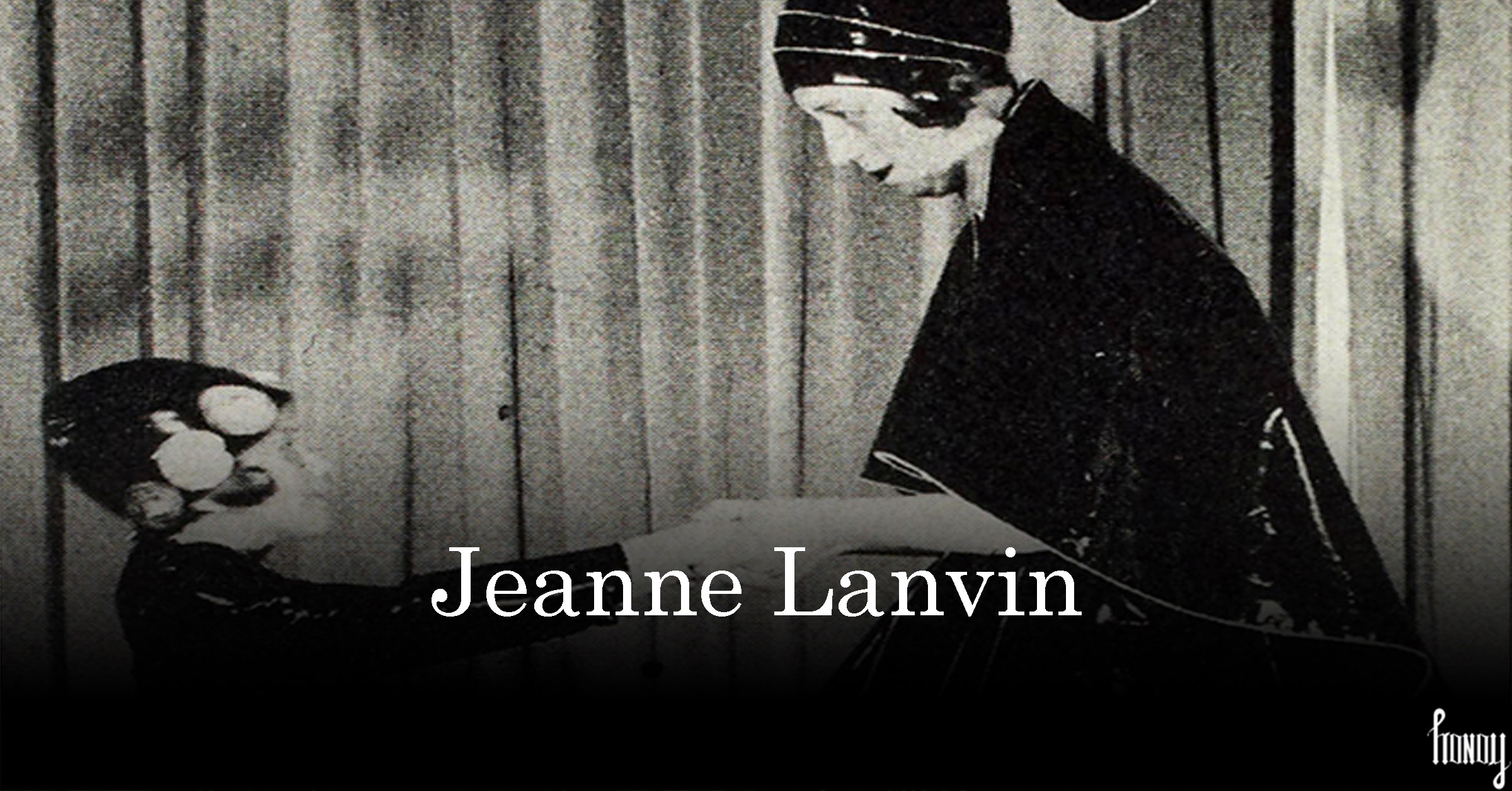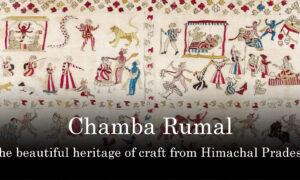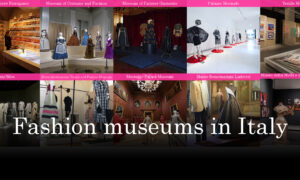About Jeanne Lanvin
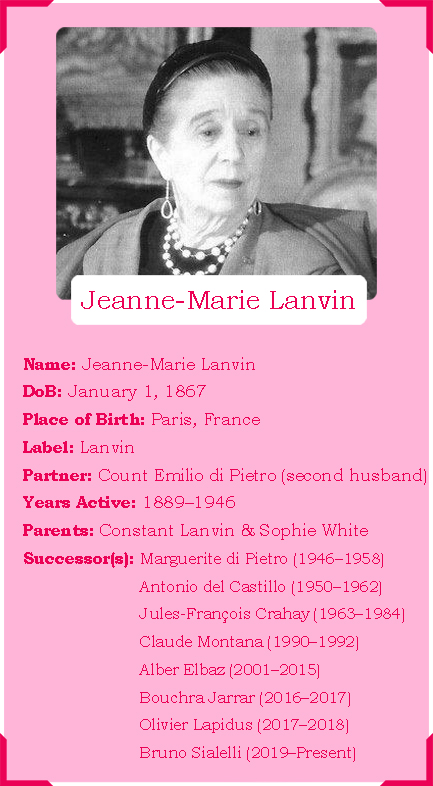
Jeanne Lanvin was not just a fashion designer; she was a visionary whose creations shaped the world of haute couture and established a standard for elegance and sophistication that still resonates today. Known for her mastery in combining rich fabrics, intricate embroideries, and a distinct sense of femininity, Lanvin is often celebrated as one of the earliest creators of French luxury fashion.
Her legacy, encapsulated in the house of Lanvin, remains one of the oldest fashion houses still in operation today. With her remarkable ability to blend timeless elegance with innovative designs, she once stated, “One cannot create without loving,” a statement that beautifully reflects the passion and creativity she infused into her work. This blog will dive deep into the life, creativity and legacy of this designer unsurpassable.
“I don’t create dresses, I create dreams.”
-Jeanne Lanvin
Early Life and Background
Jeanne Lanvin was born in the heart of Paris, a city renowned for its fashion and cultural vibrancy. Raised in a family of modest means, she was the eldest of 11 children. Her early life was marked by a struggle for resources, which cultivated in her a profound sense of determination and resilience. By age 16, Jeanne was already working as an apprentice for a milliner, Madame Félix, where she quickly learned the intricacies of hat-making. Her interest in fashion was evident from a young age as she observed and absorbed the styles and trends in the bustling streets of Paris. Largely self-taught, she honed her skills through hands-on experience and an innate flair for creativity.
Career Beginnings
In 1889, at the age of 22, Jeanne Lanvin opened her first millinery shop on Rue Boissy d’Anglas in Paris. Initially, she created hats, but her talent for design soon led her to experiment with clothing. Her breakthrough came when she started making dresses for her daughter, Marguerite, born in 1897. The sophisticated yet playful designs attracted the attention of wealthy women, who began commissioning Lanvin to create similar garments for their own children. This marked the beginning of her transition from milliner to couturière.
Jeanne’s early collections were characterized by her attention to detail, use of luxurious fabrics, and a unique blend of color palettes. Despite facing stiff competition from established designers, she managed to carve out a niche for herself by offering a style that was distinctly her own: a harmonious blend of elegance, comfort, and a touch of whimsy.
Rise to Fame
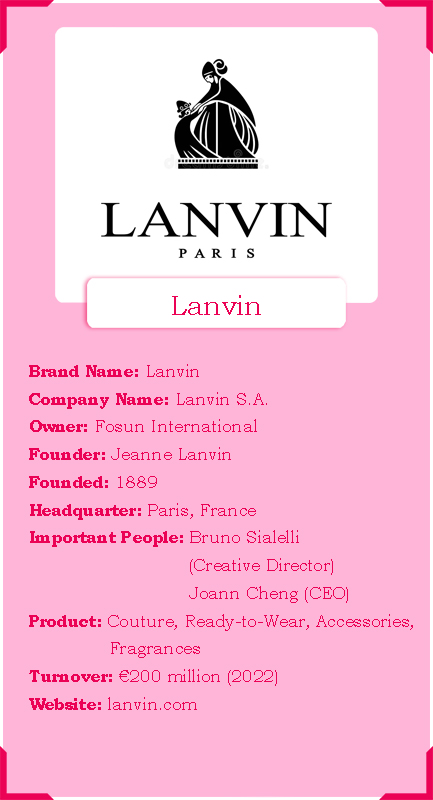
Lanvin’s career took a decisive turn in 1909 when she officially established her fashion house, Maison Lanvin, and became a member of the Chambre Syndicale de la Couture Parisienne, the governing body of French fashion. This membership allowed her to expand her brand beyond children’s clothing and into women’s couture.
One of the pivotal moments in Lanvin’s rise to fame was her iconic “robe de style,” introduced in the 1920s. This design featured a fitted bodice and full skirt, inspired by the silhouette of 18th-century gowns. It became a symbol of feminine sophistication and was a refreshing contrast to the flapper styles popular during the era. The dress’s success established Lanvin as a leader in women’s fashion, and her client list grew to include some of the most influential women in Europe, including the Duchess of Windsor and actresses like Marlene Dietrich.
In 1925, Lanvin expanded her brand by launching a line of perfumes, the most famous being “Arpège,” a fragrance inspired by the sound of Marguerite practicing her scales on the piano. The fragrance, known for its rich, floral notes, was an instant success and remains a hallmark of the brand’s offerings.
Signature Style and Innovations
Jeanne Lanvin’s signature style was characterized by an emphasis on feminine elegance, meticulous craftsmanship, and an innovative use of color. She was particularly known for her “Lanvin blue,” a shade inspired by the works of Renaissance painter Fra Angelico. This distinctive hue, a soft, ethereal blue, became synonymous with the brand and was often used in her gowns, accessories, and branding.
Lanvin also introduced several innovative techniques that set her apart from her contemporaries. Her use of intricate embroideries, appliqué work, and beading showcased her attention to detail and craftsmanship. She often drew inspiration from art, music, and literature, which gave her collections a distinctive cultural and intellectual appeal.
“One must never overlook the finish of a dress—the hem, the lining, the buttons, the ornamentation. It is a reflection of the designer’s soul.”
This quote emphasizes her attention to detail and her belief that every aspect of a garment is significant. She viewed fashion as a form of self-expression where even the smallest details matter.
Impact on the Fashion Industry
Jeanne Lanvin’s influence extended far beyond her own brand. She was a pioneer in understanding fashion as a lifestyle, creating not just clothing, but also accessories, perfumes, home décor, and even sportswear. This holistic approach laid the groundwork for modern luxury fashion houses that offer comprehensive lifestyle brands.
Lanvin also revolutionized the fashion industry by embracing new business models. She was one of the first designers to diversify her offerings and target multiple demographics, from children’s wear to menswear, making her brand accessible to a broader audience. Her understanding of the importance of branding and her foresight in creating a legacy that outlived her own career made her a formidable figure in the fashion world.
“Elegance is an attitude, not a price tag.”
-Jeanne Lanvin
Notable Collaborations and Projects
Jeanne Lanvin was known for her collaborative spirit, often working with artists, musicians, and writers to infuse her collections with cultural depth. One of her notable collaborations was with illustrator and designer Armand-Albert Rateau, who helped create the luxurious Lanvin Home line in the 1920s. Together, they designed everything from furniture to interiors, establishing a refined, sophisticated aesthetic that appealed to the European elite.
Personal Life and Public Persona
Despite her immense success, Jeanne Lanvin remained a private and enigmatic figure. She was deeply devoted to her daughter, Marguerite, who played an integral role in her creative process and eventually took over the brand’s artistic direction after Jeanne’s passing in 1946. Jeanne’s relationship with Marguerite was both professional and personal, and many of her designs were inspired by their bond.
“My greatest masterpiece is my daughter.”
Jeanne Lanvin was deeply devoted to her daughter, Marguerite, who served as her muse and inspiration. This quote highlights her personal connection to her work and the influence of motherhood on her designs.
Jeanne’s reserved nature contrasted with her status as a fashion icon. She shunned the limelight, preferring to let her work speak for itself. However, those who knew her described her as a passionate, driven, and deeply empathetic person, qualities that resonated in her timeless designs.
Legacy and Continuing Influence
Jeanne Lanvin’s legacy continues to thrive even decades after her death. Today, the House of Lanvin is one of the oldest surviving fashion houses in Paris, carrying forward her ethos of elegance, innovation, and artistry. Designers like Alber Elbaz, who served as Lanvin’s creative director from 2001 to 2015, have cited Jeanne’s work as a profound influence on their approach to fashion.
Lanvin’s influence on future generations of designers is evident in the continued popularity of her signature styles and techniques. Her commitment to quality, innovation, and a distinct sense of style remains a benchmark for excellence in the fashion industry.
The Successors of the House of Lanvin
Marguerite di Pietro (1946–1958): After Jeanne Lanvin’s death in 1946, the first in line to preserve the heritage of the house was her daughter, Marguerite Marie-Blanche Lanvin, later known as Marguerite di Pietro. As Jeanne’s closest confidante and muse, Marguerite was deeply involved in the creative process during Jeanne’s lifetime. She took on the mantle of leadership, maintaining the house’s traditions and focus on elegance and sophistication. Marguerite upheld her mother’s legacy, producing collections that echoed Jeanne’s aesthetic while subtly introducing her own influences.
However, her tenure was relatively short. Marguerite passed away in 1958, marking the end of direct family involvement in the creative direction of the House of Lanvin.
Antonio del Castillo (1950–1962): During Marguerite’s leadership period, Antonio del Castillo joined Lanvin as head designer. Known for his precision and craftsmanship, del Castillo was able to maintain the house’s reputation for sophistication and innovation. He had previously worked for other prestigious fashion houses such as Balenciaga and Paquin, and he brought a cosmopolitan and refined sensibility to Lanvin.
Under del Castillo’s direction, the house produced timeless evening gowns and impeccable tailoring. His designs were less whimsical and more structured compared to Jeanne’s original creations, yet he managed to uphold the house’s reputation for quality and elegance. Del Castillo remained at Lanvin until 1962, after which he went on to become a prominent figure in the world of haute couture.
Jules-François Crahay (1963–1984): The next chapter in the Lanvin story was written by Jules-François Crahay. Crahay, who had previously been the creative director at Nina Ricci, took over the reins at Lanvin in 1963. His approach to design was more youthful and spirited, a necessary adaptation to the rapidly changing fashion landscape of the 1960s and 1970s.
Crahay’s collections were known for their sense of freedom, fluidity, and a subtle nod to the bohemian spirit of the era. His designs, while modern, never lost touch with the house’s heritage of fine detailing and luxury. Crahay’s efforts revitalized the brand and appealed to a new generation of women. He remained at Lanvin for over two decades, becoming one of the longest-serving designers at the house.
Claude Montana (1990–1992): In the 1980s and early 1990s, the fashion world saw a shift towards more daring, avant-garde styles, and Lanvin turned to Claude Montana, a designer known for his bold, architectural creations. Montana’s tenure at Lanvin was relatively short but impactful. His collections for Lanvin featured sharp silhouettes, exaggerated shoulders, and a strong sense of power dressing that reflected the spirit of the decade.
Although Montana’s designs brought a sense of modernity to the brand, they were not commercially successful, leading to his departure in 1992. Despite the brevity of his time at Lanvin, Montana’s collections are remembered for their creativity and audacity.
Alber Elbaz (2001–2015): One of the most significant figures in the contemporary history of Lanvin is Alber Elbaz. Joining the house in 2001, Elbaz transformed Lanvin into one of the most sought-after luxury labels of the early 21st century. His designs, known for their romanticism, exquisite draping, and masterful use of color, revived the house’s fortunes and re-established it as a powerhouse in the fashion industry.
Elbaz’s vision for Lanvin was rooted in a deep respect for women and an understanding of their desires. He brought a sense of joy and whimsy to his collections, making them both wearable and aspirational. His tenure saw a string of highly successful collections, and he was beloved by fashion insiders, celebrities, and customers alike.
Elbaz’s sudden departure in 2015, following disagreements with the company’s owners, marked the end of an era for Lanvin. His influence, however, remains indelible, and he is often credited with bringing the house back to its former glory.
Bouchra Jarrar (2016–2017): Following Elbaz’s departure, French designer Bouchra Jarrar was appointed as creative director. Known for her impeccable tailoring and minimalist aesthetic, Jarrar’s appointment was seen as a move towards a more pared-down, refined style. Her collections focused on clean lines, fluidity, and understated luxury. While critically acclaimed, her approach was a departure from the more elaborate and romantic style associated with Elbaz.
Jarrar’s tenure was short-lived, however, lasting just two seasons. She resigned from the position in 2017, signaling another shift in direction for the brand.
Olivier Lapidus (2017–2018): Olivier Lapidus, known for his background in high-tech fashion and innovative textiles, succeeded Jarrar. His vision for Lanvin was to modernize the brand and make it more digitally accessible. His collections, however, struggled to resonate with critics and consumers. Lapidus left the house after just a year, making his tenure one of the briefest in Lanvin’s history.
Bruno Sialelli (2019–Present): In 2019, Bruno Sialelli was appointed as the creative director of Lanvin. Previously associated with Loewe, Sialelli brought a fresh perspective to the house. His collections blend elements of Lanvin’s heritage with contemporary influences, merging the romantic and the avant-garde.
Sialelli’s tenure has been marked by a focus on expanding Lanvin’s appeal to a younger demographic while staying true to its DNA of elegance and luxury. His ability to balance modernity with tradition has been well-received, and he continues to build on the legacy of the house by introducing playful, youthful collections that honor the brand’s past while looking towards the future.
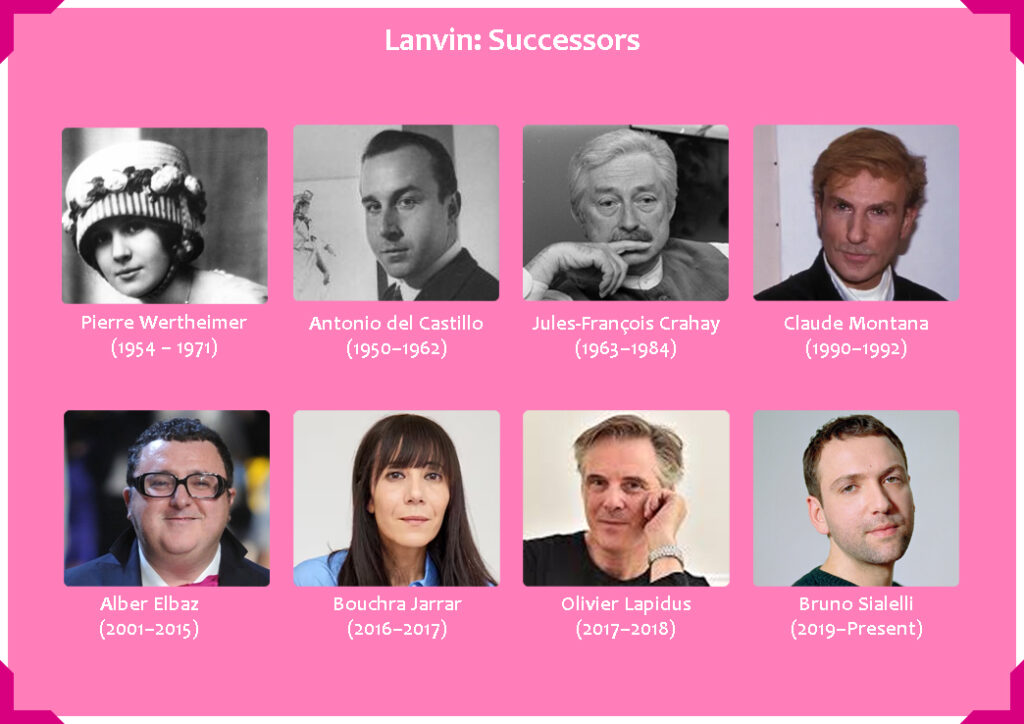
Conclusion
Jeanne Lanvin’s influence on the fashion industry goes far beyond her pioneering work as one of the first couturiers of the modern era. From her humble beginnings as a milliner to founding one of the most enduring fashion houses in Paris, she demonstrated an extraordinary ability to anticipate and adapt to the changing tastes of women over nearly six decades of her career. Lanvin’s visionary approach to design not only made her a beloved figure among the elite of her time, but also solidified her place in fashion history as a true innovator.
Her legacy is multifaceted: she was one of the first to expand a fashion brand into a lifestyle concept, offering everything from clothing to perfumes, home décor, and more. This comprehensive approach to fashion set the stage for what luxury brands would later become—houses that provide not just garments, but an entire universe of elegance and refinement. The iconic “robe de style,” Lanvin blue, and the exquisite embroideries and fabrics she used remain symbols of her unparalleled craftsmanship and artistic sensibility.
Even after her passing in 1946, Jeanne Lanvin’s name continued to resonate through the halls of high fashion. Her successors, from her daughter Marguerite to Alber Elbaz and the current creative director Bruno Sialelli, have all contributed to carrying her vision forward, each interpreting her legacy in their own unique way. This succession of talent has ensured that Lanvin remains not just a brand, but a living testament to Jeanne’s enduring influence. The house has seen both challenging times and triumphant returns, yet it has always managed to retain its core values of elegance, quality, and artistic innovation.
Lanvin’s impact on the fashion world extends beyond her creations. She broke new ground as one of the first women to achieve such prominence in the field, paving the way for future female designers in an industry dominated by men. Her success as an entrepreneur also set a precedent, proving that a fashion house could thrive on the vision of a single, determined woman. The maison’s continuous existence today is a tribute to her perseverance, creativity, and foresight.
As we look at the current state of the Lanvin brand, which has recently focused on engaging a younger, global audience while preserving its heritage, it is clear that Jeanne Lanvin’s ethos still guides the house. The brand’s ability to embrace modern trends without losing sight of its roots speaks to the timelessness of her original vision. Her legacy is not just seen in the house of Lanvin but also in the broader world of fashion, where her principles of luxury, innovation, and elegance continue to inspire designers and influence trends.
Jeanne Lanvin was not just a couturière but a cultural icon whose influence transcended fashion to shape the very notion of luxury and refinement. Her creations, her business acumen, and her understanding of fashion as a holistic lifestyle remain benchmarks in the industry. To explore the history of Lanvin is to delve into the life of a woman who, through sheer talent and passion, changed the face of fashion forever.
As the house of Lanvin continues to evolve under new creative visions, it stands as a living museum to Jeanne Lanvin’s artistry and the indelible mark she left on the world of haute couture. Her legacy, like her designs, is timeless—an eternal embodiment of grace, innovation, and the spirit of Parisian elegance. I hope you liked this ode to the greatest of designers. Please share with me your dream Lanvin creation and why do you like it. Do let me know if I missed any major points on this designer.


